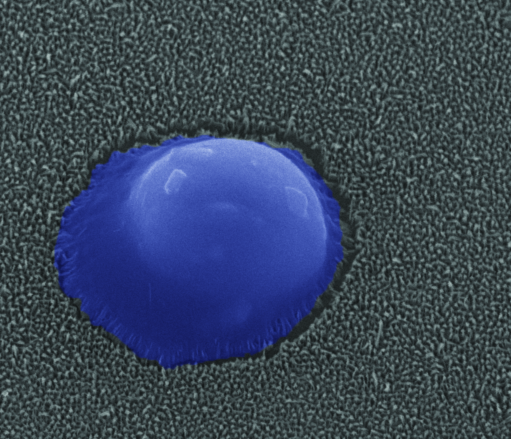Abstract
The waxy epicuticle of dragonfly wings contains a unique nanostructured pattern that exhibits bactericidal properties. In light of emerging concerns of antibiotic resistance, these mechano-bactericidal surfaces represent a particularly novel solution by which bacterial colonization and the formation of biofilms on biomedical devices can be prevented. Pathogenic bacterial biofilms on medical implant surfaces cause a significant number of human deaths every year. The proposed mechanism of bactericidal activity is through mechanical cell rupture; however, this is not yet well understood and has not been well characterized. In this study, we used giant unilamellar vesicles (GUVs) as a simplified cell membrane model to investigate the nature of their interaction with the surface of the wings of two dragonfly species, Austrothemis nigrescens and Trithemis annulata, sourced from Victoria, Australia, and the Baix Ebre and Terra Alta regions of Catalonia, Spain. Confocal laser scanning microscopy and cryo-scanning electron microscopy techniques were used to visualize the interactions between the GUVs and the wing surfaces. When exposed to both natural and gold-coated wing surfaces, the GUVs were adsorbed on the surface, exhibiting significant deformation, in the process of membrane rupture. Differences between the tensile rupture limit of GUVs composed of 1,2-dioleoyl-sn-glycero-3-phosphocholine and the isotropic tension generated from the internal osmotic pressure were used to indirectly determine the membrane tensions, generated by the nanostructures present on the wing surfaces. These were estimated as being in excess of 6.8 mN m–1, the first experimental estimate of such mechano-bactericidal surfaces. This simple model provides a convenient bottom-up approach toward understanding and characterizing the bactericidal properties of nanostructured surfaces.

Author(s) & Affilation(s)
Samuel Cheeseman1, Vi Khanh Truong1, Vivien Walter2, Fabrice Thalmann2, Carlos M. Marques2, Eric Hanssen3, Jitraporn Vongsvivut4, Mark J. Tobin4, Vladimir A. Baulin5, Saulius Juodkazis6, Shane Maclaughlin7,8, Gary Bryant1, Russell J. Crawford1, and Elena P. Ivanova1,7
- School of Science, College of Science, Engineering and Health, RMIT University, GPO Box 2476, Melbourne, Victoria 3001, Australia
- Université de Strasbourg, CNRS, Institut Charles Sadron, UPR022, 23 rue du Loess, 67034 Strasbourg Cedex, France
- Advanced Microscopy Facility, Bio21 Institute, University of Melbourne, 30 Flemington Rd, Parkville, Victoria 3010, Australia
- Infrared Microspectroscopy Beamline, Australian Synchrotron, 800 Blackburn Road, Clayton, Victoria 3168, Australia
- Departament d’Enginyeria Quimica, Universitat Rovira, Virgili, 26 Av. dels Paisos Catalans, 43007 Tarragona, Spain
- Centre for Micro-Photonics and Industrial Research Institute Swinburne, Faculty of Science, Engineering and Technology, Swinburne University of Technology, P.O. Box 218, Hawthorn, Victoria 3122, Australia
- ARC Research Hub for Australian Steel Manufacturing, Wollongong, New South Wales 2522, Australia
- BlueScope Steel Research, Port Kembla, New South Wales 2505, Australia
Cite this publication
Cheeseman et al., Interaction of Giant Unilamellar Vesicles with the Surface Nanostructures on Dragonfly Wings, Langmuir 2019, 35, (6), 2422–30
You can access the publication directly on this link.